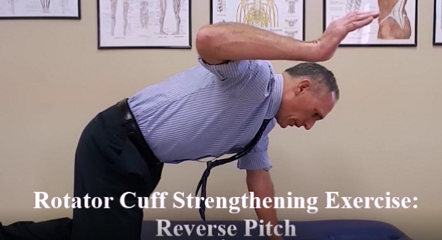Strengthen your rotator cuff muscles to prevent shoulder injuries, enhance shoulder function and improve your posture. Build coordination, stabilize the shoulder joint and balance shoulder strength by utilizing the reverse pitch exercise.
Anatomy: The rotator cuff is a group of four muscles that connects the shoulder blade to the upper arm. The supraspinatus, infraspinatus and teres minor muscles begin on the back of the shoulder blade and attach to the top and back of the upper arm bone. The subscapularis muscle originates on the front of the shoulder blade and connects to the front of the upper arm bone. Collectively these muscles are called the rotator cuff or S.I.T.S. muscles.
The rotator cuff muscles contract to move the shoulder and upper arm. The concentric, or positive, action of the supraspinatus, infraspinatus and teres minor muscles pulls the shoulder and upper arm backwards. The eccentric, or negative, action controls and decelerates forward shoulder motion. These smaller muscles are usually stressed in an eccentric manner.
The posterior rotator cuff muscles work in conjunction with the posterior aspect of the deltoid and the scapular retractor muscles of the midback to pull the shoulder blades and shoulder backward.
Strength Imbalance: The rotator cuff muscles are smaller muscles often overpowered by their stronger opposing muscles. The pectoralis major and pectoralis minor are powerful muscles that pull the shoulder forward. The big and strong latissimus dorsi muscles originate in the back but attach to the front of the upper arm. Even though the subscapularis muscle is part of the rotator cuff it contracts to move the shoulder forward.
The larger muscles that attach to the front of the shoulder have a biomechanical advantage over the posterior shoulder muscles. As a unit the muscles in the front of the shoulder are thicker muscles which are used more frequently than the posterior shoulder muscles. This results in strength imbalances in which the anterior shoulder muscles overpower and inhibit the posterior shoulder muscles.
A shoulder strength imbalance leads to poor upper body posture and incorrect shoulder biomechanics. A strength imbalance in the shoulder is a precursor to numerous painful, performance limiting conditions.
Poor upper body posture occurs when the shoulders are pulled forward and the scapulae are pulled away from the spine. Incorrect shoulder positioning leads to poor motion and faulty joint biomechanics. Painful, performance limiting conditions such as subacromial impingement syndrome, bicipital tendinopathy and rotator cuff syndrome result from shoulder strength imbalances.
Combat shoulder strength imbalances by developing the posterior shoulder muscles. Build strength in the rotator cuff and posterior shoulder to correct posture and improve shoulder function. Proportional strength in the shoulder is a key ingredient to healthy shoulder function.
Target the rotator cuff, scapular retractors and posterior deltoid with one exercise by performing a backwards throwing motion called the reverse pitch. The reverse pitch works the posterior shoulder muscles in a concentric and eccentric manner. Build strength, coordination and stability in the shoulder joint with two versions of the reverse pitch.
Kneeling Reverse Pitch: Assume a kneeling position with one knee and one hand on a firm training table or bench. Hold your spine straight and keep your head in line with your spine. Allow your shoulder and shoulder blade to stretch downward by hanging your arm as low as possible with your palm facing backward. Without shrugging your shoulder retract your shoulder blade by pulling it toward the spine. Bend your elbow and raise your arm as far back as possible at a 90-degree angle from your body. Rotate your shoulder upward until your palm faces the floor. Slowly lower your arm in the reverse fashion controlling the eccentric phase of the exercise.
Breakdown the kneeling reverse pitch into three steps while perfecting your technique. Concentrate on each phase and develop perfect technique for maximum benefit. Perform the exercise in increments until the motion become flawless. Once the motion feels seamless begin to utilize one fluid motion.
Start with zero resistance and concentrate on technique and the working muscles. Building coordination and developing flawless technique is much more important than the resistance level. Even if only one side is injured, train both sides.
Begin with an appropriate number of repetitions that work for you and progress to fifteen reps. Execute one set in the beginning and slowly advance to three sets. Perform this exercise after you’ve finished your upper body training.
Standing Reverse Pitch: The standing reverse pitch is a backwards throwing motion. Utilize very light resistance with a cable or therapy band connected to a sturdy structure at waist height.
Stand up straight with your feet shoulder width apart. Hold your right hand in a gentle fist in front of your left thigh. Firmly grip the resistance band with your palm facing backwards. Retract both shoulder blades by pinching the bottom corners together. Bend your right elbow to 90 degrees and raise your right arm until it is parallel to the floor and pulled backward as far as possible. Rotate your shoulder backwards until your palm faces forward. Slowly lower your arm in the exact opposite manner and control the eccentric phase of the exercise.
Flawless technique is a necessity when performing the reverse pitch. Focus on your form. If needed, breakdown the exercise into three segments. Once you are comfortable with each segment, use one fluid motion.
Practice with no resistance until your technique is perfect. When ideal form is achieved begin using therapy bands with very light tension.
Start with a small number of repetitions you can perform symptom-free with seamless technique. Build slowly to fifteen reps with precise form. Work both sides, even if only one side is injured. Execute the reverse pitch exercise after completing your back and shoulder training, never beforehand.
Strategy: Incorporate the reverse pitch exercise into your training strategies to prevent and manage shoulder conditions. Start at an appropriate level for you and increase intensity gradually.
Perform the reverse pitch two to three times a week with one or two days of rest in between training sessions. Allow your body ample time to rest and recover between workouts.
Combine the reverse pitch with other exercises for optimum results. Reverse dumbbell flyes with light dumbbells and isometric scapular retractions build strength in the posterior deltoid and scapular retractor muscles respectively. Thoracic extension increases mid back strength. Rectify poor posture, eliminate shoulder strength imbalances and improve shoulder function by correctly executing the reverse pitch exercise to build proportional shoulder strength.
Dr Donald A Ozello DC of Championship Chiropractic in Las Vegas, NV
Web Site: http://www.championshipchiropractic.com/
Blog: https://www.championshipchiropractic.com/wordpress/
YouTube: https://www.youtube.com/user/drdozellodc/videos
Twitter: https://twitter.com/drdozellodc
Facebook: https://www.facebook.com/Championship-Chiropractic-280141628688300/
LinkedIn: https://www.linkedin.com/in/dr-donald-a-ozello-dc-716b3233
“Running: Maximize Performance & Minimize Injuries” https://www.amazon.com/Running-Performance-Chiropractors-Minimizing-Potential/dp/1493618741
**Disclaimer: Always consult a medical professional before beginning an exercise program. Always work within your capabilities. Never perform an exercise that elicits or increases pain or symptoms. Reading this article and viewing the linked videos does not take the place of seeing a medical professional. Please visit a medical professional for evaluation, diagnosis & treatment.

